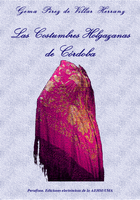Las costumbres holgazanas de Córdoba
 1
/
1
1
/
1

Las costumbres holgazanas de Córdoba
Gema Pérez de Villar Herranz
Perséfone, 2014
Para citar este libro:
Pérez de Villar Herranz, Gema (2014). Las costumbres holgazanas de Córdoba. Perséfone
Palabras clave
Derecho Castellano | Bienes gananciales| Historia jurídica | Igualdad de Género| Córdoba
Resumen
Este proyecto analiza las llamadas “Costumbres Holgazanas de Córdoba”, un conjunto de prácticas jurídicas que negaba a las mujeres el derecho a los bienes gananciales tras la disolución del matrimonio, limitándolas a recibir únicamente su dote y arras. Desde un enfoque jurídico e histórico, el texto examina el contexto en que surgieron estas costumbres, su evolución y las distintas teorías sobre su origen, considerando posibles influencias del derecho romano, visigodo y musulmán. Con un tono formal y analítico, la autora aborda el estudio desde la perspectiva del Derecho Castellano, explorando su relación con otras instituciones como el Fuero de Baylío y la legislación posterior que llevó a su abolición en 1801. A través del análisis documental y doctrinal, se ofrece una reflexión crítica sobre las desigualdades legales de género presentes en el sistema jurídico de la época y sobre el proceso de unificación legal en España.
Key Words
Castilian law |Marital community property | History of Law| Gender equality| Córdoba
Abstract
The study examines the so-called “Lazy Customs of Córdoba”, a set of historical legal practices which denied women the right to shared marital property after the dissolution of marriage, granting them only their dowry and wedding gifts. From a legal and historical perspective, the text explores the context in which these customs emerged, their evolution, and the various theories about their origin, considering possible influences from Roman, Visigothic, and Muslim law. With a formal and analytical tone, the author approaches the subject within the framework of Castilian Law, exploring its relationship with other institutions such as the Fuero de Baylío and the later legislation that led to its abolition in 1801. Through documentary and doctrinal analysis, the study offers a critical reflection on the legal gender inequalities of the time and on the broader process of legal unification in Spain.





